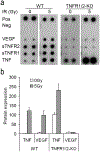Blockade of tumor necrosis factor alpha signaling in tumor-associated macrophages as a radiosensitizing strategy
- PMID: 20145121
- PMCID: PMC8849568
- DOI: 10.1158/0008-5472.CAN-09-2995
Blockade of tumor necrosis factor alpha signaling in tumor-associated macrophages as a radiosensitizing strategy
Abstract
Most cancer patients receive radiotherapy during the course of their disease. Improvements in the therapeutic index have been based mainly on physical improvements in delivery, as radiosensitizer development to target tumor cells has yet to yield effective agents. Recent investigations have focused on the tumor stroma as a target for radiosensitization. Here, we report that depletion of tumor-associated macrophages (TAMvarphi) by systemic or local injection of the macrophage-depleting liposomal clodronate before radiotherapy can increase the antitumor effects of ionizing radiation (IR), either as a large single dose (20 Gy) or as a fractionated dose (2 Gy x 10). Coimplantation of tumor cells with bone marrow-derived macrophages (BMDMvarphi) increased tumor radioresistance. Studies using mice with germline deletions in tumor necrosis factor receptors 1 and 2 (TNFR1,2(-/-)) or TNFalpha (TNF(-/-)), or treatment of wild-type mice with a soluble TNF receptor fusion protein (Enbrel), revealed that radioresistance mediated by BMDMvarphi required intact TNFalpha signaling. Radiation exposure upregulated vascular endothelial growth factor (VEGF) in macrophages and VEGF-neutralizing antibodies enhanced the antitumor response to IR. Thus, the radioprotective effect of TNFalpha was mediated by TAM-produced VEGF. Our findings offer a mechanistic basis to target macrophage populations generally or TNFalpha-induced macrophage VEGF specifically as tractable strategies to improve the efficacy of radiotherapy.
Figures






Similar articles
-
Macrophage-derived tumor necrosis factor-alpha is an early component of the molecular cascade leading to angiogenesis in response to aortic injury.Arterioscler Thromb Vasc Biol. 2011 May;31(5):1151-9. doi: 10.1161/ATVBAHA.111.223917. Epub 2011 Mar 3. Arterioscler Thromb Vasc Biol. 2011. PMID: 21372301 Free PMC article.
-
Translational strategies exploiting TNF-alpha that sensitize tumors to radiation therapy.Cancer Gene Ther. 2009 Apr;16(4):373-81. doi: 10.1038/cgt.2008.86. Epub 2008 Oct 31. Cancer Gene Ther. 2009. PMID: 18974777 Free PMC article.
-
Neutralization of tumor necrosis factor bioactivity ameliorates urethane-induced pulmonary oncogenesis in mice.Neoplasia. 2011 Dec;13(12):1143-51. doi: 10.1593/neo.111224. Neoplasia. 2011. PMID: 22241960 Free PMC article.
-
Hypoxic tumor cell radiosensitization: role of the iNOS/NO pathway.Bull Cancer. 2008 Mar;95(3):282-91. doi: 10.1684/bdc.2008.0592. Bull Cancer. 2008. PMID: 18390408 Review.
-
The influence of apigenin on cellular responses to radiation: From protection to sensitization.Biofactors. 2025 Jan-Feb;51(1):e2113. doi: 10.1002/biof.2113. Epub 2024 Aug 12. Biofactors. 2025. PMID: 39134426 Review.
Cited by
-
Anti-tumour strategies aiming to target tumour-associated macrophages.Immunology. 2013 Feb;138(2):93-104. doi: 10.1111/imm.12023. Immunology. 2013. PMID: 23113570 Free PMC article. Review.
-
Radiation-induced effects and the immune system in cancer.Front Oncol. 2012 Dec 17;2:191. doi: 10.3389/fonc.2012.00191. eCollection 2012. Front Oncol. 2012. PMID: 23251903 Free PMC article.
-
Impaired lymphatic function accelerates cancer growth.Oncotarget. 2016 Jul 19;7(29):45789-45802. doi: 10.18632/oncotarget.9953. Oncotarget. 2016. PMID: 27329584 Free PMC article.
-
Tumor-associated macrophages: an accomplice in solid tumor progression.J Biomed Sci. 2019 Oct 20;26(1):78. doi: 10.1186/s12929-019-0568-z. J Biomed Sci. 2019. PMID: 31629410 Free PMC article. Review.
-
Radiotherapy combined with immunotherapy: the dawn of cancer treatment.Signal Transduct Target Ther. 2022 Jul 29;7(1):258. doi: 10.1038/s41392-022-01102-y. Signal Transduct Target Ther. 2022. PMID: 35906199 Free PMC article. Review.
References
-
- Salama JK CS, Mehta N, Yenice KM, Stadler WM, Vokes EE, Haraf DJ, Hellman S, and Weichselbaum RR. An initial report of a radiation dose escalation trial in patients with one to five sites of metastatic disease. Clinical Cancer Research. 2008. - PubMed
-
- Vokes EE, Panje WR, Mick R, Kozloff MF, Moran WJ, Sutton HG, Goldman MD, Tybor AG, Weichselbaum RR. A randomized study comparing two regimens of neoadjuvant and adjuvant chemotherapy in multimodal therapy for locally advanced head and neck cancer. Cancer. 1990;66:206–13. - PubMed
-
- Masunaga S, Hirayama R, Uzawa A, Kashino G, Suzuki M, Kinashi Y, Liu Y, Koike S, Ando K, Ono K. The effect of post-irradiation tumor oxygenation status on recovery from radiation-induced damage in vivo: with reference to that in quiescent cell populations. J Cancer Res Clin Oncol. 2009;135:1109–16. - PubMed
-
- Roses RE, Xu M, Koski GK, Czerniecki BJ. Radiation therapy and Toll-like receptor signaling: implications for the treatment of cancer. Oncogene. 2008;27:200–7. - PubMed
Publication types
MeSH terms
Substances
Grants and funding
LinkOut - more resources
Full Text Sources
Other Literature Sources
Molecular Biology Databases

